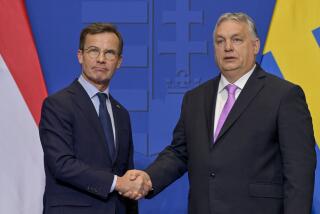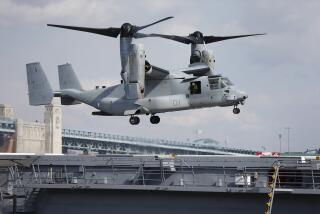Prototype Jet’s Crash Renews Debate on Sweden Funding Costly Project
- Share via
STOCKHOLM — When a prototype of Sweden’s newest jet fighter recently skidded off the runway and somersaulted on landing, the accident rekindled debate over whether a small nation could fund such a big military project.
Already running 2 years behind schedule amid huge cost overruns, the crash near the Saab-Scania factory at Linkoping in southern Sweden further delayed the JAS-Gripen project, although by how long no one is yet able to say.
There is also concern that Sweden could be without a full attack-force capacity around 1995.
“The accident could be the swan song for the entire Swedish plane industry,” said aerodynamics professor Sven-Olof Ridder. “The JAS project has reached a dangerous position, its entire credibility depending on whether it can be completed within a reasonable time and cost frame,” said Ridder, who conducts tests on the JAS at the Royal Institute of Technology.
Since the Feb. 2 crash, in which the only operational prototype was written off, Prime Minister Ingvar Carlsson has emphasized how important an independent aircraft industry is for Sweden’s neutrality.
“I am not yet prepared to make any judgments about JAS,” he said after the crash. But he added that Sweden’s neutral policies “will weigh heavily in the balance when a decision is taken. . . .”
“We need to know the reasons and have cleared up the problems within 6 months,” said Gen. Maj. Gunnar Lindqvist, head of the aviation division of the government’s defense procurement division. “Otherwise we will have to reassess the whole project,” he told the Dagens Nyheter newspaper.
Even before the crash, it was uncertain whether JAS would ever be operational because the government and the consortium building it are arguing over who should cover more than $1 billion of extra costs.
The consortium is led by vehicle and aerospace manufacturer Saab-Scania AB.
The Defense Ministry had threatened to scrap the project, but Sweden’s chief of staff recently published a report recommending that it should continue despite the budget overrun.
The cost of delivering the first 140 aircraft to the Swedish Air Force was originally put at 25.7 billion crowns at 1981 prices ($6.4 billion at current prices).
“Sweden is certainly one of the few, if not the last European country, which has embarked on this kind of go-it-alone military development,” said Guy Norris of London-based defense information group Jane’s. “The last country was Israel, which eventually canceled its Lavi fighter project for the (U.S.-built) F-16. There are such enormous costs involved it is almost impossible to go it alone,” he added.
Before the crash, the air force was expecting to have its first JAS squadron operational in 1995. The aircraft would replace the aging ground attack version of the Viggen.
“If delivery is going to be further delayed, it would be possible to extend the flying age of the Viggen after 1995, although for how long depends on how much money is spent,” said Gosta Edwards, air force spokesman.
“The other alternative is to have fewer planes, which in the long run would weaken our preparedness. Where we go from here depends on economic and political factors,” Edwards said.
The JAS is billed as a multipurpose, single-seat fighter controlled by advanced computer avionics with radar-guided air-to-air and air-to-ground missiles. It is able to take off and land on roads as well as airfields.
The second test prototype was due to fly by March but will now have to wait for the investigation report and any subsequent modifications. The chief investigator says there is no sign that the pilot, who escaped with a broken arm, made a mistake.
Much attention regarding the cause of the crash has been focused on the JAS’s computerized steering system, which has to compensate for an intrinsic imbalance in the plane’s design, aeronautic analysts say.
Saab-Scania has said that its aircraft division, already struggling because of the JAS-linked investments, would not be able to survive on civilian projects alone. But managing director Georg Karlsund has rejected speculation that the JAS project might be canceled.
“If we laid off all production and lost all that technical competence it would be a hard blow for the economy,” he said.
More to Read
Sign up for Essential California
The most important California stories and recommendations in your inbox every morning.
You may occasionally receive promotional content from the Los Angeles Times.













